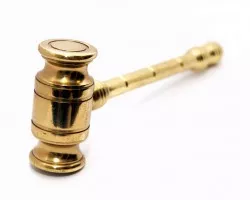In 1994, as corporations were locating vast reserves of oil and gas on Indian reservations, a feisty middle-aged woman named Elouise Cobell decided the time had come for the federal government to account for how it divvied up and awarded mineral royalties on Indian lands.
As a community organizer in the small town of Browning, Mont., Cobell was familiar with the machinery of government in both her tribal world and in Washington, D.C. What began for her as a suspicion — a hunch that the federal government and mineral corporations had been stealing from the poor and giving to the rich — soon became a certainty, leading her to make a formal complaint in federal district court. Once Cobell filed the suit in 1996, it quickly grew into one of the most complicated class-action lawsuits ever brought against the U.S. government. On one side were Uncle Sam’s Department of Justice and the Department of the Interior. On the other side were Cobell and 390,000 Indian plaintiffs who lived all over the West.
Cobell alleged that the Interior Department, in collusion with energy companies, had stolen mineral royalties owed to the Indians since the late 1800s. Accountants for the firm of Price-Waterhouse conducted an initial review of the government’s books, or more accurately of such books as the government could produce. In their 1998 report to federal district court Judge Royce Lamberth, the accountants pulled no punches.
Some $50 billion had gone missing from Indian Country accounts. In 2003, after twice citing Interior secretaries for contempt of court for chronic foot-dragging and malfeasance, Judge Lamberth, a west Texas judge appointed by the first President Bush, ruled in favor of the plaintiffs. In words seldom heard from a federal bench, the judge called the Interior Department a “dinosaur … the hand-me-down of a disgracefully racist and imperialist government…”
With the basic question of culpability settled, straightening out the accounting could begin in earnest. Or could it? In 2005, at the urging of the second Bush White House, which had accused the judge of being “too harsh on the government,” Lamberth was removed from the case by an appeals court in Washington, D.C.
Lamberth’s replacement in 2008, Judge James Robertson, attempted to satisfy the Indians’ claim by awarding them $455.6 million. Cobell scoffed at the figure and declared that Robertson’s decision would not stand. “It’s factually wrong and legally wrong, so we have to challenge it,” she said. Cobell kept plugging and appealed the decision.
Last month, the long-running case inched its way toward closure when Cobell and her lawyers, along with their new counterparts in the departments of Justice and Interior, announced that they’d arrived at a $3.4 billion settlement. The final paperwork may take months to get through Congress, but translated into real-world numbers, this would amount to a $1,000 payment to every plaintiff in the case.
Like Judge Lamberth, President Obama made it clear that he viewed this suit as a stain on the nation; he hailed the settlement as “an important step towards sincere reconciliation between the government and the Indians.”
We’ll see. After spending 20 years in the West dealing with white settlers and Indian chiefs, General William Tecumseh Sherman described Indian reservations as “a parcel of land set aside for the exclusive use of Indians [and] surrounded by thieves.”
If you happen to live in the Indian communities of White Shield, Window Rock or Lame Deer in 2010, you’re left to ask: Has anything changed in 100 years? Craig Miner, author of The Corporation and the Indian, has an answer. He says that the stolen Indian trust funds provided one of the principle sources of capitalization for industries in the extractive sector during the 20th century. The long-term abuse of those funds, says Miner, raises the question of whether money held in trust for the protection of the Indians ought to have been used to exploit and impoverish them. Of course, that last bit was a lesson in understatement.
For the moment, Cobell has settled — for pennies on the dollar — the question of stolen mineral royalties and their (token) restitution. But only fools, as Craig Miner, Judge Lamberth and General Sherman warn us, will be duped into thinking that the thieves have turned over a new leaf.
Paul VanDevelder is a journalist in Portland, Oregon, and the author of Savages and Scoundrels: The Untold Story of America’s Road to Empire through Indian Territory. This commentary first appeared in High Country News (www.hcn.org).
















